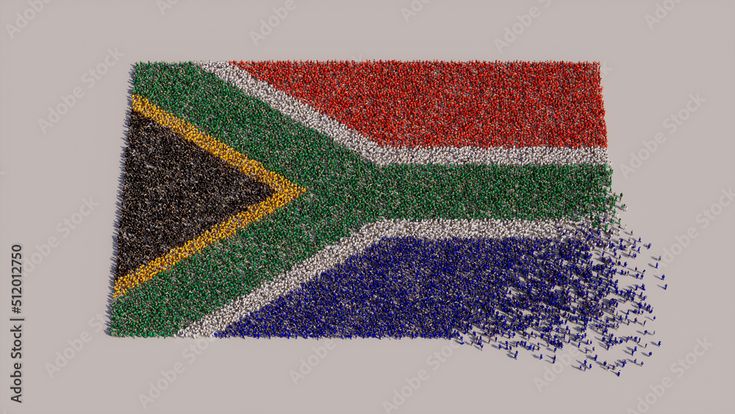The South African cultural banner, primarily represented by the national flag, is more than just a piece of fabric. It is a vivid tapestry that encapsulates the nation’s rich history, diverse cultural heritage, and aspirations for the future. South Africa’s flag features a unique combination of colors and shapes, each imbued with meaning, making it an emblem of identity for millions.
A closer examination of the flag reveals its intricate design. The flag consists of a green Y-shape that is bordered by black and yellow, intertwined with red, blue, and white. Each color and arrangement embodies the spirit of the nation. The green Y signifies the convergence of diverse peoples and the vibrant land. The black represents the African population, while yellow denotes the country’s wealth in mineral resources. Red reflects the struggles endured, blue symbolizes the skies, and white represents peace. Together, these colors are not merely decorative; they narrate South Africa’s multifaceted identity.
While the national flag serves as the country’s banner, the concept of a cultural banner extends beyond this singular emblem. South Africa is home to various ethnic groups, each with its own unique cultural symbols and banners that reflect their history and traditions. These cultural banners often manifest in the form of clothing, art, and rituals, which are vital in celebrating their diverse heritages. Such expressions of identity are significant, as they foster pride and unity among communities.
One sees this cultural plurality vividly captured during national events and festivities. For example, the annual Heritage Day is a melange of colors and symbols, where various ethnic groups display their unique banners, traditional attire, and performances. From the beadwork of the Xhosa to the vibrant patterns of Zulu clothing, each cultural expression plays an essential role in showcasing South Africa’s collective narrative.
The richness of South African cultural banners can also be observed in art and literature. Many contemporary artists and writers draw heavily on the motifs of their respective cultures, weaving them into a narrative that speaks to both the past and the present. Public murals and sculptures scattered across cities depict significant historical figures and events, often showcasing a blend of traditional and modern styles. These artistic representations serve not only as a reminder of the struggles faced by various communities but also as a celebration of their resilience and hope for a brighter future.
Furthermore, language is a vital aspect of South Africa’s cultural banner. With 11 official languages, each language group has its own folklore, proverbs, and oral traditions that enrich the national dialogue. The beauty of this linguistic diversity lies in its capacity to convey complex concepts, values, and tales that resonate deeply with the people’s collective consciousness. This cultural tapestry is constantly evolving, as new languages and dialects emerge, influenced by globalization, migration, and social integration.
The significance of South African cultural banners extends to the realm of politics and social movements. The fight against apartheid, for instance, galvanized the nation, giving rise to iconic symbols that represented the struggle for freedom and equality. Banners adorned with slogans, images of freedom fighters, and symbolic colors became synonymous with the resistance movement. Even today, social movements continue to draw upon these cultural representations to advocate for various causes, be it environmental justice, economic inequalities, or gender rights, weaving a rich tapestry of activism that reflects the diverse voices of South Africans.
Education plays a crucial role in preserving these cultural banners and fostering a sense of pride in young generations. Schools in South Africa increasingly incorporate cultural studies into their curricula, teaching students about the history, customs, and traditions of various ethnic groups. By doing so, the younger generation is equipped with the knowledge to appreciate the complexity and beauty of their nation’s heritage. This awareness breeds respect and empathy, paving the way for a more inclusive society.
Additionally, the global cultural landscape presents both challenges and opportunities for South African cultural banners. As globalization permeates every aspect of life, South Africa faces the risk of cultural homogenization, where unique cultural identities may overshadow traditional practices. However, this predicament also opens up avenues for cultural exchange and collaboration. Festivals, exhibitions, and cultural fairs that celebrate South African heritage can thrive internationally, allowing communities to share their treasures with the world.
In sum, the South African cultural banner is an intricate amalgamation of history, art, language, and collective memory. It serves as both a celebration of diversity and a reminder of the trials faced throughout history. The South African flag, while central to national identity, symbolizes a broader narrative encompassing numerous cultural expressions, each contributing to the nation’s rich mosaic. As South Africa continues to evolve, this cultural banner will undoubtedly adapt and change, ensconcing new stories while honoring the old, ensuring that the spirit of unity and determination remains as vibrant as ever.
In conclusion, the exploration of South African cultural banners unravels a profound narrative, one that encapsulates the essence of resilience, beauty, and unity amid diversity. The colors, shapes, and symbols embody the struggle and triumphs of a nation that has embraced its multifaceted identity, standing as a testament to the enduring spirit of its people.
